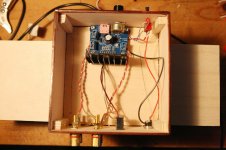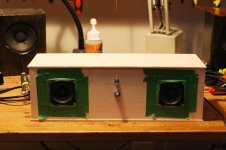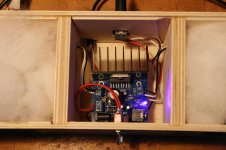Please excuse the crumby photos.
Here are 2 examples of the little stereos that I’m making with these lunch box amps. Could you knowledgable guys advise me if I am not running the wires properly or how to make it better. I have not properly twisted the wires on the unfinished one. I am always concerned about grounding in wooden boxes.
Thanks!
Here are 2 examples of the little stereos that I’m making with these lunch box amps. Could you knowledgable guys advise me if I am not running the wires properly or how to make it better. I have not properly twisted the wires on the unfinished one. I am always concerned about grounding in wooden boxes.
Thanks!
Attachments
Wooden enclosures
I put all my amps in wooden enclosures and never have any sort of noise/grounding problems.
I'm certainly no expert, but your wiring looks fine to me. My wiring is much "looser" shall we say? A lot less neat. No problems. The amps seem fairly forgiving in that respect.
MW
I put all my amps in wooden enclosures and never have any sort of noise/grounding problems.
I'm certainly no expert, but your wiring looks fine to me. My wiring is much "looser" shall we say? A lot less neat. No problems. The amps seem fairly forgiving in that respect.
MW
My board modified, was able to fit 6 elna cap on board and inductor between them.

Sent from my ONE A2001 using Tapatalk

Sent from my ONE A2001 using Tapatalk
It is an normal car amp chip, so 6 amperes.How much current does the 7297 chip need from the power supply?
It is an normal car amp chip, so 6 amperes.
Interesting. The datasheet states maximum output current of two amps. I assume that is for the entire chip? Are you saying that 4 amps of current are lost as heat? At 18 volts, that would be 72 watts of heat to dissipate. Am I right?
If 50% efficiency, half of 6 amperes is 3. I have no idea where the 1 ampere got lost, but it usually does. No matter how much I'd like to know, I'm sort of afraid of the answer. Actually, I have no idea how you do 2*22W on only 4a at the rated voltage. That is in the datasheet.Interesting. The datasheet states maximum output current of two amps. I assume that is for the entire chip? Are you saying that 4 amps of current are lost as heat? At 18 volts, that would be 72 watts of heat to dissipate. Am I right?
Example: 22.5 VDC × 2 Ampere = 45 Watt? 45 Watt × 90% = 40.5 Watt for music? Like 2×20 Watt?
I also want to understand...
P.S.: I know that Folsom TDA7297 amplifier can take about 22 - 23 VDC....
I also want to understand...
P.S.: I know that Folsom TDA7297 amplifier can take about 22 - 23 VDC....
Last edited:
Example: 22.5 VDC × 2 Ampere = 45 Watt? 45 Watt × 90% = 40.5 Watt for music? Like 2×20 Watt?
I also want to understand...
You and me both! Not sure where the 22.5 volts came from, as the max voltage is 18. But let's use 16 volts and an 8 ohm speaker load. Remember, 16 volts peak equals 11.312 volts RMS. From Rod Elliott (kind of)...
The power output is determined by the load impedance
and the available voltage and current of the amplifier.
An amplifier that is capable of a maximum of 2A output
current will be unable to provide more just because
you want it to. Such an amp will be limited to
16W "RMS" into 8 ohms, regardless of the supply voltage.
Likewise, an amp with a supply voltage of +16V
will be unable to provide more than 16W RMS into
8 ohms, regardless of the available current. Having
more current available will allow the amp to
provide (for example) 32W into 4 ohms (4A peak current)
or 64W into 2 ohms (8A peak current), but will
give no more power into 8 ohms than the supply
voltage will allow.
Does this make sense?
I assume by 90% you are referring to the efficiency of the amp? At that rate, the amp would draw 2.222 amps input to get 2 amps output, I think.
Missed your P.S. Folsom's amp reduces the voltage to 17.5 (I think) before it gets to the chip.
If you reduced it a tad more (to 15.8V) you could use some extremely low ESR capacitors on the supply rails (Nichicon HZ) which are only available up to 16V. But the reduction in power output may not appeal.
I assume by 90% you are referring to the efficiency of the amp?
I don't think he's referring to the efficiency of the amp. This is not a class D amp.
What is the 90%?
I'm not sure the ESR gain of 2-4mohm per cap is really worth using the HZ over SEFP/FP. Consider there's 12.
I'm not sure either (I suggested it more as an experiment) but you do get more capacitance too, not just lower ESR.
Good question. What's the 7297 efficiency?I don't think he's referring to the efficiency of the amp. This is not a class D amp.
What is the 90%?
I don't think he's referring to the efficiency of the amp. This is not a class D amp.
What is the 90%?
The 7297 is a classAB amplifier and its efficiency varies according to the signal at its input. Best case is at full output where it might reach 70%.
Pretty impressive caps those with 8mohm ESR @ 100kHz. Wonder what the ESR is at 20kHz?
I just stuck one of my Nichicon HZ (1800uF/16V) on my LCR meter. It measures 4.7mohm at 100kHz, 6.7mohm at 20kHz. They were a lot, lot cheaper than polymers.
I just stuck one of my Nichicon HZ (1800uF/16V) on my LCR meter. It measures 4.7mohm at 100kHz, 6.7mohm at 20kHz. They were a lot, lot cheaper than polymers.
HZ is out of production and like any type that is, suddenly they appear in china 🙂
Water is a very low esr electrolytic and chinese water based electrolytics do not last long, but that may be reason Nichicon discontinued them too, where some failure reports I believe. 20.000 hours for the polymer 🙂
Water is a very low esr electrolytic and chinese water based electrolytics do not last long, but that may be reason Nichicon discontinued them too, where some failure reports I believe. 20.000 hours for the polymer 🙂
You're assuming the ones I have are Chinese copies? Can't fault the projected lifetime of polymers 🙂 With the price differential I think I can replace all my HZ dozens of times, should they fail. This is DIY after all, not aerospace 😀
- Home
- Amplifiers
- Chip Amps
- What the heck? It's less than lunch!


